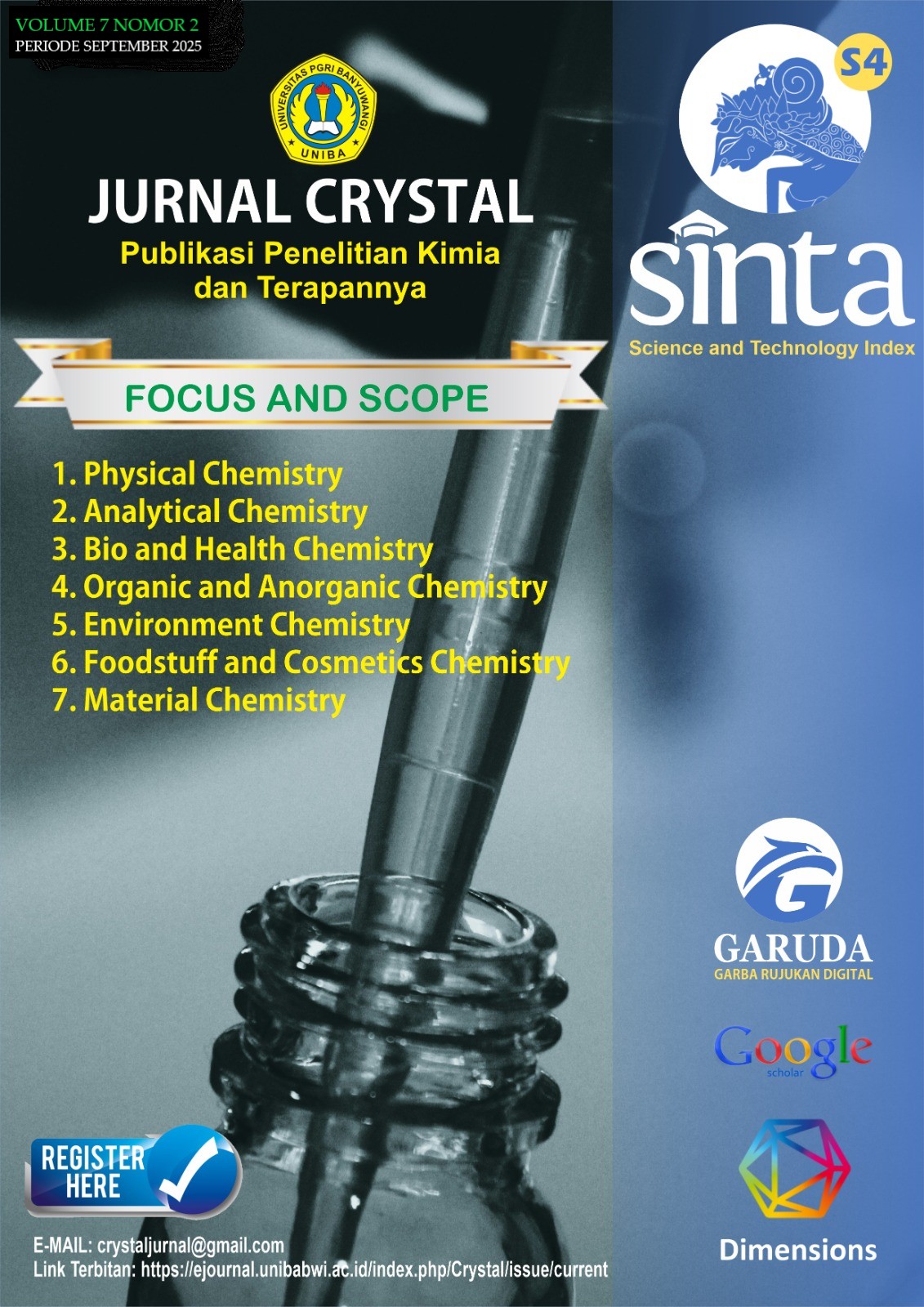ANALISIS SPEKTROFOTOMETRI EKSTRAK BUNGA TELANG BERDASARKAN VARIASI WAKTU MASERASI SEBAGAI KANDIDAT SENSITIZER PADA DYE SENSITIZED SOLAR CELL (DSSC)
DOI:
https://doi.org/10.36526/jc.v7i2.6221Keywords:
DSSC, sensitizer, butterfly pea flower, macerationAbstract
Increasing population growth causes an increase in energy demand, which causes global
warming and climate change. Therefore, a renewable energy source is needed, namely solar
energy. DSSC offers the potential for lower production costs compared to conventional solar
cells. However, currently the commonly used sensitizer is ruthenium-based which is expensive
and harmful to the environment. Therefore, a natural sensitizer is sought, namely from butterfly
pea flowers which contain anthocyanin pigments that can absorb light and convert it into
electrons. The purpose of this study was to determine the functional groups of butterfly pea
flowers and determine the effect of maceration time on the maximum wavelength of butterfly
pea flower extract as a sensitizer candidate in DSSC. The method used was maceration of
butterfly pea flower powder using 70% ethanol solvent with variations in maceration time,
namely 24 hours, 48 hours and 72 hours. Spectrophotometric analysis was carried out using
FTIR to determine the functional groups contained in butterfly pea flowers and UV-Vis to
determine the maximum wavelength in butterfly pea flower extract. The result is that there is
a strong absorption band at a wave number of 3279.96 cm-1 indicating the presence of O-H
group stretching which indicates that the butterfly pea flower is rich in anthocyanins. The
maximum wavelength of the butterfly pea flower is that there are 2 peaks at 576 nm and 621
nm. Variations in maceration time do not affect the maximum wavelength of the butterfly pea
flower but affect the absorbance, the lowest absorbance is 24 hours of maceration time followed
by 48 hours of maceration time and the highest is 72 hours of maceration time. The conclusion
is that the main compound contained in the butterfly pea flower is anthocyanin and 72 hours of
maceration time shows the highest absorbance so it can be used as the most optimal sensitizer
candidate.
References
Abdellah, I. M., & El-Shafei, A. (2020). Efficiency enhancement of ruthenium-based DSSCs
employing A-π-D-π-A organic Co-sensitizers. RSC Advances, 10(47), 27940–27953.
https://doi.org/10.1039/d0ra03916k
Castillo-Robles, J. A., Rocha-Rangel, E., Ramírez-De-león, J. A., Caballero-Rico, F. C., &
Armendáriz-Mireles, E. N. (2021). Advances on dye-sensitized solar cells (DSSCs)
nanostructures and natural colorants: A review. In Journal of Composites Science (Vol. 5,
Issue 11). MDPI. https://doi.org/10.3390/jcs5110288
Chan, C. H., Yusoff, R., & Ngoh, G. C. (2014). Modeling and kinetics study of conventional and
assisted batch solvent extraction. In Chemical Engineering Research and Design (Vol. 92,
Issue
6,
pp.
1169–1186).
Institution
https://doi.org/10.1016/j.cherd.2013.10.001
of
Chemical
Engineers.
Deepa, H. A., Madhu, G. M., & Venkatesham, V. (2019). Performance evaluation of DSSC’s
fabricated employing TiO2and TiO2-ZnO nanocomposite as the photoanodes. Materials
Today: Proceedings, 46, 4579–4586. https://doi.org/10.1016/j.matpr.2020.09.711
Jeyaraj, E. J., Lim, Y. Y., & Choo, W. S. (2021). Extraction methods of butterfly pea (Clitoria
ternatea) flower and biological activities of its phytochemicals. In Journal of Food Science
and
Technology
(Vol.
58,
Issue
https://doi.org/10.1007/s13197-020-04745-3
6,
pp.
2054–2067).
Springer.
Kalmankar, N. V., Venkatesan, R., Balaram, P., & Sowdhamini, R. (2020). Transcriptomic profiling
of the medicinal plant Clitoria ternatea: identification of potential genes in cyclotide
biosynthesis. Scientific Reports, 10(1). https://doi.org/10.1038/s41598-020-69452-7
Lakshmi, M. (2014). IDENTIFICATION OF BIOACTIVE COMPOUNDS BY FTIR ANALYSIS AND IN
VITRO. September.
Lana, G. M., Bello, I. T., Adedokun, O. M., Adenigba, V. O., Jubu, P. R., Adedokun, O., Sanusi, Y.
K., Dhlamini, M. S., & Awodugba, A. O. (2024). One-Dimensional TiO2 Nanocomposite-based
Photoanode for Dye-Sensitized solar Cells: A review. In Solar Energy (Vol. 279). Elsevier
Ltd. https://doi.org/10.1016/j.solener.2024.112850
Mahatmanti, F. W., Alauhdin, M., & Kusumaningrum, S. B. C. (2024). Smart and Green Packaging
Made from Chitosan-based Biofilm with the Addition of Ginger Oil and Anthocyanins from
Butterfly
Pea
Flower
Extract
(Clitoria
Ternatea
https://doi.org/https://doi.org/10.14710/jksa.27.2.53-63
L.).
27(2),
53–63.
Marpaung, A. M., & Pustikarini, D. (2023). Spectrophotometric Change of Butterfly Pea (Clitoria
ternatea L.) Flower Extract in Various Metal Ion Solutions During Storage. Science and
Technology Indonesia, 8(3), 367–372. https://doi.org/10.26554/sti.2023.8.3.367-372
Oguis, G. K., Gilding, E. K., Jackson, M. A., & Craik, D. J. (2019). Butterfly pea (Clitoria ternatea),
a cyclotide-bearing plant with applications in agriculture and medicine. In Frontiers in Plant
Science (Vol. 10). Frontiers Media S.A. https://doi.org/10.3389/fpls.2019.00645
Omar, A., Ali, M. S., & Abd Rahim, N. (2020). Electron transport properties analysis of titanium
dioxide dye-sensitized solar cells (TiO2-DSSCs) based natural dyes using electrochemical
impedance spectroscopy concept: A review. In Solar Energy (Vol. 207, pp. 1088–1121).
Elsevier Ltd. https://doi.org/10.1016/j.solener.2020.07.028
Oshina, I., & Spigulis, J. (2021). Beer–Lambert law for optical tissue diagnostics: current state of
the art and the main limitations. Journal of Biomedical Optics, 26(10).
https://doi.org/10.1117/1.jbo.26.10.100901
Prajapat, K., Mahajan, U., Sahu, K., Dhonde, M., & Shirage, P. M. (2024). The Evolution of natural
Dye-Sensitized solar Cells: Current Advances and future outlook. In Solar Energy (Vol. 284).
Elsevier Ltd. https://doi.org/10.1016/j.solener.2024.113081
Putri, S. A., Farhani, A. D., Anjani, A. S., Saragih, A. D., Nuri, P., Sari, N., & Susanto Gultom, N.
(2025). JOURNAL OF APPLIED MECHANICAL ENGINEERING AND RENEWABLE ENERGY
(JAMERE) Transformasi Teknologi dalam Sel Surya Film Tipis Generasi Kedua. ISAS, Vol. 5
No. https://journal.isas.or.id/index.php/JAMERE
Rudia, F., Viena, V., & Sartika, Z. (2024). Uji Karakteristik dan Potensi Ekstrak Bunga Telang
(Clitoria Ternatea L.) di Banda Aceh menggunakan FTIR Sebagai Zat Aditif Antioksidan.
Journal Serambi Enggineering, 9(1), 8050–8054.
Saud, P. S., Bist, A., Kim, A. A., Yousef, A., Abutaleb, A., Park, M., Park, S. J., & Pant, B. (2024).
Dye-sensitized solar cells: Fundamentals, recent progress, and Optoelectrical properties
improvement strategies. In Optical Materials (Vol. 150). Elsevier B.V.
https://doi.org/10.1016/j.optmat.2024.115242
Thuy, N. M., Ben, T. C., Minh, V. Q., & Van Tai, N. (2021). Effect of extraction techniques on
anthocyanin from butterfly pea flowers (Clitoria ternatea L.) cultivated in Vietnam. Journal
of
Applied
Biology
and
https://doi.org/10.7324/JABB.2021.96022
Biotechnology,
9(6),
173–180.
Trida, P., Perwito Program Studi Farmasi, D., & Sains dan Kesehatan, F. (2022). Optimasi
Perbandingan Pelarut dan Lama Maserasi terhadap Kadar Total Antosianin Ekstrak Jantung
Pisang (Musa acuminata x Musa balbisiana) Optimization of Solvent Comparison and
Maceration Duration to Total Anthocyanin Levels of inflorescence Extract (Musa acuminata x
Musa
balbisiana).
In
Jurnal
Farmasi
http://journals.ums.ac.id/index.php/pharmacon
Indonesia
(Vol.
19,
Issue
2).
Wahyuningsih, S., Wulandari, L., Wartono, M. W., Munawaroh, H., & H, R. A. (2017). The Effect
of pH and Color Stability of Anthocyanin on Food Colorant. Materials Science and
Engineering. https://doi.org/10.1088/1757-899X/193/1/012047
Downloads
Published
How to Cite
Issue
Section
License
Copyright (c) 2025 Fadia Mutiara Putri, Sherly Kasuma Warda Ningsih

This work is licensed under a Creative Commons Attribution 4.0 International License.















